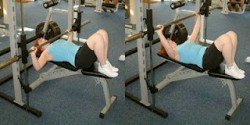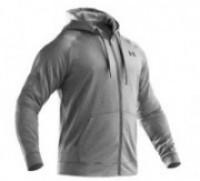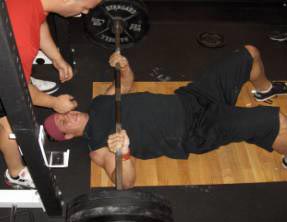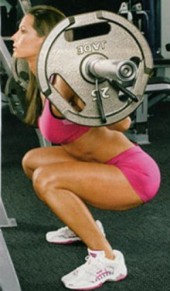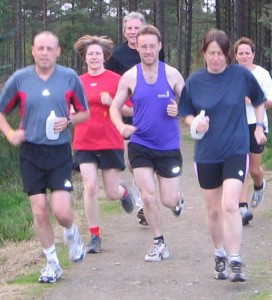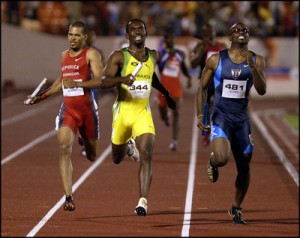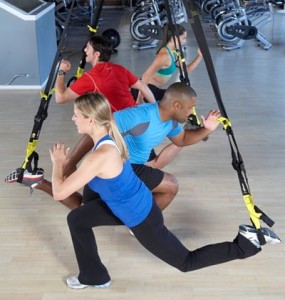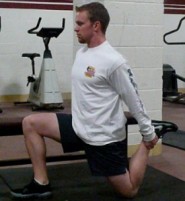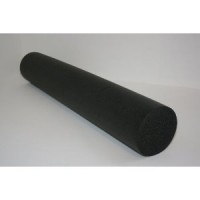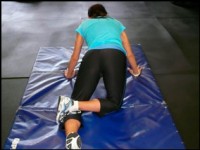Stay Athletic and Bench Press with Proper Form…
March 21, 2012 by danny · Leave a Comment
In doing my usually weekly reading of all things fitness related, I came across a couple posts that I think the majority of people can benefit from…
5 Ways to Maintain or Improve Your Athleticism By Jason Ferruggia
Yes, the aging process makes it so we are not as athletic (not as fast, powerful, and explosive) as we once were. But another big reason that we lose SOOOO much of our athletic ability as we age, is because we no longer perform athletic movements. So, don’t blame everything on your age. Sitting on your butt and/or not working out like an athlete is just as big of a culprit for not being able to touch the net rim anymore. In THIS article Jason goes over 5 ways to maintain or improve your athleticism.
Bench Press Technique: Should You Keep Your Feet Up? By Eric Cressey
Every guy in the world lives to bench. And I don’t see this changing anytime soon. I have nothing against the bench press, but I DO have a problem with HOW MUCH emphasis the typical dude puts on this exercise. BUT, if you’re going to do it, you might as well do it right. EC asks the question; “Should You Keep Your Feet Up?” Short answer is, NO! To get the reasons why, check out THIS post.
And if you are feeling lazy and don’t feel like doing any further reading, check out the video below of me benching along with some cues to ensure you are using proper bench press technique.
If any of your buddies are “Mr. Bench Press,” (you know, the guy that benches 3 times a week, 52 weeks out of the year), be sure to share this post with him. It’ll help save his shoulders in the long run.
That’s it for now. Until next time…
The Cliffs Notes Version of Great Fitness Information
December 6, 2011 by danny · Leave a Comment
I know most of your are not personal trainers/fitness coaches/strength & conditioning coaches (whatever you want to call me). Therefore you don’t have all day to spend in front of the computer reading articles, attending seminars, or watching training/nutrition DVDs. But at the same time, you want the best training and nutrition information that you can get your hands on. No worries, that’s what I am here for (you can thank me later). When I’m not actually training clients and myself, I DO spend a lot of time scouring the web for great fitness information that I can apply to help make me a better trainer to those that I work with. With that said, here are some great little nuggets of of fitness tips that you can start applying right away en route to your fitness goals…
Eric Cressey made this blogpost a couple months back, and I’ve been meaning to share it with my readers – especially since winter is coming. Here is the portion of his post, that I wanted you all to see:
“Warm-up – This seems like a no-brainer, but you’d be amazed at how many people jump right into their weight training program of the day without even getting their body temperature up. It’s well documented that performance improves as core body temperature rises. However, as this study demonstrated, even a lowered skin temperature can decrease force output – independent of core body temperature. So, it may be advantageous to start your day’s strength training program in long sleeves and remove layers as you go. I prefer to see folks sweating by the time the warm-up ends; set aside at least ten minutes for it so that you can get some foam rolling and mobility drills in.”
More and more information is being gathered, suggesting that dental health may play a key role in overall health. In Charles Poliquin’s recent blogpost, he states:
“Researchers found that individuals who had had their teeth cleaned and scaled once over that period reduced their risk of heart attack by 24 percent, and lowered stroke risk by 10 percent compared to those who never had their teeth professionally cleaned. Plus, the more frequently that participants had their teeth cleaned, the more of a reduction in heart attack risk they experienced.” And …
If you have friends or family members that can benefit from this information, be sure to share it and/or hit the like button below…
“Cardio” To Perform When Sore…
July 13, 2011 by danny · Leave a Comment
A number of years back Eric Cressey came out with an article called Cardio Confusion. Since that article, I’ve been incorporating “active recovery circuits” on my off days. Now, I don’t do them NEARLY enough, but whenever I do, I feel much better as they 1) help speed recovery, and 2) help improve mobility (which most of us need to improve). And a nice little “side effect” is some low impact calorie burning to help us with our health and fat loss goals.
One of the worst thing you can do (and way too many people are doing this), is say, “I am SO sore from my workout yesterday! Therefore I’m just going to veg-out on the couch all day today.” That will do nothing to speed up the recovery process, and contribute to the build-up of knots/adhesions all over your body. Going on a fast-paced walk (and moving in general) is a much better way to spend your off days. Even better though, is putting your body through a full range of motion, as you’ll see below.
There are number of ways to set up these active recovery days;
-You can perform dynamic flexibility circuits (address areas of your body that are tight).
-You can do low-intensity resistance exercises (pick a handful of exercises and cycle through them).
-Or, as I like to do, throw some dynamic flexibility circuits in WITH the low-intensity resistance exercises.
Here are the exercises I did in yesterday’s active recovery/cardio session…
I just started a new program earlier in the week. And as you probably know, when you start a new program the chances of soreness are higher. Going into my cardio session yesterday, my pecs, glutes, and adductors (inner thighs) were especially sore. So it was perfect timing to perform this active recovery day. For the purposes of not boring you to death, I only recorded an example with 4 reps per exercise. Normally I perform 10-12 reps (sometimes up to 20 reps) per exercise (6-10 exercises).
Above, you see
-Goblet Squats
-Push-ups
-RDL/Bent Over Row (hybrid)
-Wall Hip Flexor Mobilizations (to address my tight quads)
-Hip Thrusts
-Reverse Lunge with Twist
I did 3 rounds of this circuit. I also started off the workout with foam rolling/LAX ball and finished with static stretching at the end of my active recovery/cardio circuit.
Move from one exercise to the next with minimal rest and when it comes time to do the low-intensity resistance exercises, MAKE SURE you pick a lighter weight. This should NOT turn into another “regular” weight lifting session, as that would just defeat the purpose.
Remember, when you train hard, you have to recovery smart. Give this, or a similar set-up a try and reap the benefits!
Baseball Coaches, Baseball Parents – MUST READ!
April 26, 2011 by danny · Leave a Comment
Throwing a baseball is one of the most dangerous actions in all of sports. The chances of players hurting their shoulder and/or elbow are already high enough. Why increase those chances even more!?! Most parents and baseball coaches don’t know that they don’t know (that they are a BIG part of the injury problem). Well, Strength Coach Eric Cressey is here to help all of us involved with parenting or coaching young baseball players. If you’ve been contributing to the problem (even inadvertently), it’s time to learn, and make some adjustments. After all, that’s what life is all about – learning and APPLYING what you learn to make improvements.
Enjoy this great piece from Eric.
How to Get Athletes Faster
October 13, 2010 by danny · Leave a Comment
As a strength coach and basketball coach I’ve had many parents ask me over the years; “how do I get my son/daughter faster?” More often then not, these well-intended parents/coaches figure the best way to improve speed is to have the young athletes do agility drill after agility drill. But they leave out a VERY important component to improving speed – strength training. Both Eric Cressey and Mike Boyle do a great job of addressing the importance of getting stronger in the quest to becoming faster. You can check them out here…
As Coach Boyle points out; ”The best solution to slow feet is to get stronger legs.”
If you are a parent, or a coach of a sport, and the “sciency” type of stuff that Mr. Cressey & Boyle are talking about has you a little confused, just know that the more force you are capable (by getting stronger through weight training) of putting into the ground, the faster you are going to be able to run, the quicker you are going to be able to stop, and the higher you are going to be able to jump. And I couldn’t agree more with Eric – many sport seasons go year around these days (i.e. a basketball player or volleyball player that has their regular season, then it’s off to spring league, followed by summer league, followed by fall league. And then mix in a few camps in the summer, and a number of open gyms… as you can see, it is NON-STOP!). I think it’s fair to say that these athletes are spending more than enough time working on agility. Their non-playing time would be better spent getting stronger, as opposed to going to “speed” camps in which the coaches/trainers focus on movement training – where the majority of what they do is more agility drills, with no weight training.
If you read Eric and Mike’s posts, and my thoughts from above, I’m pretty confident that you are “sold” on how important strength training is to becoming a faster athlete. But just in case you are still not buying it, think about some of the fastest athletes in the world… sprinters in track and “skill” players in football (defensive backs, running backs, receivers). These are athletes that are moving some serious weight in the weight room!
So, if you are a parent or coach to an athlete(s) and do not have access to a qualified strength coach in your area, where do you begin? The biggest advice I can give you is to keep it simple for now, work on form, and focus on big, compound movements with free weights (i.e. lunges rather than leg extensions) Here is a good place to help you get started – http://bit.ly/cj4T3v. And don’t be thrown off by the title of the article. This would be a good place to start for most young athletes. Now go get some people stronger!
Should Your Max Always Be Your True Max?
August 23, 2010 by danny · Leave a Comment
The other day I worked up to a 2 rep max (RM) with trap bar deadlifts. After I finished the 2RM, I could have “easily” (ok, not easily, but I certainly left some weight on the table) added more weight and gotten a higher 2 RM for the day. And no, I’m not acting like the typical internet forum hero and making claims that have no truth. Here’s the video for proof…
That is 405 pounds X 2. *** While certainly no world record, it is not bad since I currently weight just under 160 pounds (“bulking season” is just around the corner however ![]() ) After I finished rep #2, I felt as if I could have done another 2-3 reps, or done another set and added at least another 20 pounds to the bar and continued working up to my 2 RM for the day. I decided to do neither. At this point in my life, in my opinion, it is not worth it. I’m 34 now, and my main goal is to have a buff, healthy body. If I were to continue working up to a higher weight, only to round my lumbar spine and herniate a disk, I’d be very pissed at myself. If I continued to work up to a heavier weight for the next 4-5 weeks in my program, and hit 450 X 2, or 475 X 1 (or whatever), would I really be healthier and more buff? Maybe, maybe, maybe a touch bigger. Every exercise we do in the weight room has a risk:reward attached to it. Going for a number considerably bigger than 405 X 2 on deadlifts to me, is riskier than what the reward would bring. When doing deads, my goal is to go as heavy as possible while having perfect, or near perfect form on every rep. If you look at the video, I think my form is good for lifting a weight that is more than 2.5 times heavier than I am. But it is not perfect. (And how much sloppier would it get if I were to continue working up to a higher max?) I slightly extend my neck as I lift the bar off the floor. And my hips rise SLIGHTLY before my shoulders but overall, I’m happy with the lift. Certainly much better than many deadlift attempts that you’ll see out there…
) After I finished rep #2, I felt as if I could have done another 2-3 reps, or done another set and added at least another 20 pounds to the bar and continued working up to my 2 RM for the day. I decided to do neither. At this point in my life, in my opinion, it is not worth it. I’m 34 now, and my main goal is to have a buff, healthy body. If I were to continue working up to a higher weight, only to round my lumbar spine and herniate a disk, I’d be very pissed at myself. If I continued to work up to a heavier weight for the next 4-5 weeks in my program, and hit 450 X 2, or 475 X 1 (or whatever), would I really be healthier and more buff? Maybe, maybe, maybe a touch bigger. Every exercise we do in the weight room has a risk:reward attached to it. Going for a number considerably bigger than 405 X 2 on deadlifts to me, is riskier than what the reward would bring. When doing deads, my goal is to go as heavy as possible while having perfect, or near perfect form on every rep. If you look at the video, I think my form is good for lifting a weight that is more than 2.5 times heavier than I am. But it is not perfect. (And how much sloppier would it get if I were to continue working up to a higher max?) I slightly extend my neck as I lift the bar off the floor. And my hips rise SLIGHTLY before my shoulders but overall, I’m happy with the lift. Certainly much better than many deadlift attempts that you’ll see out there…
Your Goals, Your Call
If you think I’m being a big wuss for not really caring too much about not getting my deadlift up considerably higher, that is fine. And if your goal is to deadlift as much weight as humanly possible, I am completely cool with that. I get it. Lifting heavy weight is definitely an important component to having a muscular body. That is why I have worked up to deadlifting over 400 pounds. But I am not competing in powerlifting and again, adding some lbs to the bar in this lift won’t do a ton to making me more jacked. Even Eric Cressey, a former competitve powerlifter who has a deadlifted over 600 pounds has stated this in an article…
Category 1: Weekend warriors who deadlift to improve functional capacity and correct or prevent imbalances.
Category 2: Athletes who deadlift to improve performance and bulletproof themselves against injury.
Category 3: Powerlifters who deadlift to get better at deadlifting.
Logically, I’m willing to take more chances in category #3 than I am in #2, and certainly #1. Weekend warriors don’t get aggressive loading parameters (singles over 90%). And while athletes might get to pull heavy singles, they only get to do so in a controlled environment (elevated trap bar deadlifts, pulls against chains).
A veteran athlete would blur the line between #1 and #2, and a more resilient up-and-coming athlete would be more of a “true” #2.
According to Eric’s categories of deadlifting, at this point in my lifting “career,” I put myself in category #1, merging with category #2, as my competitive juices get flowing sometimes and I can’t help but “really going for it!” But I’m certainly not willing to go into category number 3 just to add a few pounds to the bar.
Other Lifts
There are plenty of other lifts out there where going ALL OUT with weight carries a much smaller risk. And on those lifts I often work up to a true max (and have my clients do the same), whether that means a 1 RM, 8 RM, or any other rep range that I am working in. For example, the other day I worked up to a 1 RM with chin-ups. I hit 100 lbs X 1…
Later on in that same training session I did some hammer curls…
If I ended up picking a weight that had me falling a little short on that chin-up (missing a lift – rarely, if ever a goal), I think my injury status would still = healthy. Same thing with exercises like curls.
Moral of the Story
I hope you don’t think I am saying that you should not try to get stronger in certain lifts, like the deadlift. Getting a big(ger) deadlift will do wonders for your physique. But with certain lifts, I want you to ask yourself how important it is to really go for a true max. While in other exercises, pushing it to a true max is probably worth it. Only you can answer the importance of what category you put each lift in within your training goals. As I get older, I get smarter and am comfortable of knowing when to hold back a touch, and when to completely go for it.
*** Like I mentioned, 405 X 2 is not a world record. But it is a world record for the most weight ever lifted while listening to John Mayer. What the hell was that!?!
Some Thoughts on Periodization
August 10, 2010 by danny · 7 Comments
The scary P word. I’ve known many people that would prefer to spend the entire day at the dentist rather than talk (or think about) periodization. Most people just want to go lift and turn their brain off for one hour, 3 to 4 days out of the week. To a certain point, I can see why this is the mind-set of many trainees. After all, you don’t have to look very hard to hear one trainer make a particular suggestion (no matter what the topic – reps, sets, form, tempo, etc), only to read 5 other trainers give 5 different opinions. Well, I’m here to help simplify.
I’m not going to get into a 12-month periodization plan that involves in-season, early off-season, general off-season, and pre-season planning. If you train athletes and are looking for a great resource, check out Eric Cressey’s, “The Ultimate Off-Season Training Manual.” This is a must for your coaching library!
For the purposes of this post however, I’m not going to be giving my thoughts on periodization for athletes (although some of this information can be useful if you are an athlete or train athletes). I’ll be speaking more to the trainee just looking to improve his or her health and physique.
-For the most part, you don’t need to plan more than a month in advance. Don’t get me wrong, I do think it is smart to look down the road for more than a month at what you are looking to accomplish. For example, I don’t recommend doing three straight blocks focusing on hypertrophy, then move on to a fat loss phase for a month, only to go right back into a hypertrophy phase. Just randomly throwing a fat loss block in there doesn’t really fit, and probably would hurt your chances to maximally put on muscle. But the bottom line, don’t sit on your butt for a month straight trying to figure out the perfect macrocycle when you could have been in the gym getting closer to your goals during that time.
-Psychology/motivation is huge! Yeah, full body (FB) training is great for fat loss. But let’s say that you just spent your last two training blocks (8 weeks total) training FB and you CAN’T STAND the thought of going into another FB block. After all, it can be very draining to know that you are going to be doing a deadlift or squat variation AT EVERY SINGLE session, EVERY SINGLE week. Even if a body part split may be less than perfect for fat loss purposes, it can be very motivating to know you are about to head to the gym, and NOT have to squat or deadlift. “Today’s back and biceps? Sweet, I can’t get to the gym soon enough!” Be sure to keep this in mind as you head into your next training block (or a block sometime down the line).
-I’ve tried just about every combination of fluctuating volume over the course of a training block (4 weeks). I’ve tried the Cressey Performance way (at least this is the way they typically set up a block the last time I checked), which is;
- Week 1 – High Volume
- Week 2 – Medium Volume
- Week 3 – Very High Volume
- Week 4 – Low Volume (Deload)
Then, there is a the Results Fitness way (again, last time I checked);
- Intro Week
- Base Week
- Overload Week
- Shock Week
Coach Alwyn Cosgrove sets it up so each week is harder than the next. Essentially, you build up each week so by the last week you are hitting your highest loads of the block and maybe setting some PR’s in the process. Then the next week you will start a new block, with the lowest volume (basically, your deload week).
There are other ways to set up this week-by-week fluctuation in volume/intensity. But right now, here is what I have been doing for some time now…
- Week 1 – Intro Week; Volume is lower than week 2 and 3 and I stay a little further from failure on this week. Basically, when bar speed is slower than rep 1, I stop the set. This isn’t set in stone, as I’m not really too scared about overtraining if I am doing some curls. So if I “grind” out a few reps on certain exercises, I’m cool with it. But I doubt you’ll see me doing multiple sets to failure with front squats, for example.
- Week 2 – Volume goes up and I may have a few more of the “grindy” reps than on week one. Still, I never go ’til I purposefully miss a rep
- Week 3 -Similar to week 2
- Week 4 – Deload week; volume is similar to week 1, maybe even a little lower (for the females, check out this article that I wrote awhile back – something to think about)
Justification
When I was doing the Cressey Performance set-up, I personally didn’t like to go into a high volume week when starting a new block. In week one of a new block, you are switching up exercises, sets, and reps. This greatly increases the chances of soreness. And then add to the fact that it is high volume week, I found this to be a recipe to have me limping around for days (especially on exercises that tend to make us sore anyway. i.e. RDLs). This is why I have since switched to week 1 being a low(er) volume week. I figure, I am going to be sore anyway on week 1, why make it even worse.
The Results Fitness way is great, but here I found I didn’t like the psychological aspect real well. By the time week 4 of the same program roles around, I’m actually getting a little bored. The last thing I want to do is make this my hardest week. A slight mental break, by going low(er) volume, is nice here. Plus, it helps to keep my feeling fresh going into the new block in the week to come.
For the above reasons, I’ve settled in on liking the approach that I am currently using. I am also a fan of “cybernetic periodization” (going by feel). So, if week 2 or 3 calls for 5 x 3, but I am feeling like superman, I may do 7 sets of 3 that week. On week’s 1 & 4 I try to fight this temptation as I don’t think my superman-like feeling would be worth it as it would negatively effect the week to come (risk:reward = not worth it). I must say however, that although I do like cybernetic periodization, I am not a big fan of just winging it (although on rare occasion this can be good psychologically… there’s that word again). I am fan of having a training template, but giving yourself a little freedom to adjust according to how you are feeling on that particular day.
I definitely do NOT think that the Cressey Performance and Results Fitness plans are wrong. You can probably look at ANY 4-week set-up and find something imperfect about it - including the model I am currently using. When I work with a client long enough, quite often I will have him/her try a few types of 4 week set-ups. I will go over the potential pros and cons with them, and get their thoughts after trying each plan. Together we then go with a plan that gets them the most fired up and motivated to train. Thus far, “my” current 4-week plan has been the most popular with my clients. This doesn’t necessarily mean anything, I’m just sayin’. ![]()
Finally, if you are reading this and are in your first year of serious lifting, you should look at most of the above as a bunch of mumbo-jumbo. BUT, I want you to save this, study it again after a year, and consider my thoughts as far as which training split to use (answer – use them all ![]() ), and which 4-week plan to go with. Remember, consider both physiological, and psychological factors. Happy planning!
), and which 4-week plan to go with. Remember, consider both physiological, and psychological factors. Happy planning!
Should I Run?
May 25, 2010 by danny · Leave a Comment
To run or not to run, that is the question. Running/jogging is something people having been doing for years and years. And I believe it is something that people looking to drop a few pounds will continue to do ’til the end of time. But, is running the best way to “get in shape” and lose weight? Is it even a good way at all? While reading my thoughts below, please don’t think I am biased towards the weight room and power/strength activities due to the fact that I am a strength coach. If anything, my natural bias would be towards distance running as I grew up in a house where my dad was a cross country coach. And one of my brothers is currently the head cross country coach at a high school. I’ve completely thought about both sides of the discussion – running is the best way EVER to lose some weight; and running is a crap form of cardio for weight loss. I’m not saying I have all answers, but again, I’ve put a ton of thought into this over the years, worked with a ton of clients and talked with many other coaches in this field about this topic. So, if at the end of this you disagree with me, that is fine. All I ask is that you read with an open mind and consider my thoughts when making up your mind whether or not you should put much time into running to accomplish your goals. For the sake of this post, I’m talking about a distance that takes 20 minutes or more of non-stop running.
Different “Types” of People
Running For Sports – (Remember, throughout this piece I am speaking of going out on runs/jogs that last 20 minutes or more, non-stop) For most sports, I think running is a bad idea. What sport do you know that involves 20 + minutes of non-stop running? I can think of cross country. If I think hard enough I may be able to come up with a couple more. But most sports involve quick bursts followed by a brief rest. i.e. player sprints all out for 10-15 seconds, the ball goes out of bounds, he/she takes a break, the ball is thrown in bounds and this is repeated throughout the course of the game. For cross country, heck yeah you need to get your distance running in. If you compete in cross country, make sure you run distance, but also make sure you incorporate sprints and weight lifting. If all you do is run long distance at a slower than race pace, you’ll become good at running slow. Not good! Here is a great read from strength coach Eric Cressey for cross country (or those that are out of high school and enjoy competing in road races) runners and coaches talking about the importance of resistance training for runners.
The Person Looking to Drop Some LBS. – I think I first heard this quote from Strength Coach Mike Boyle; “Don’t run to get fit, get fit to run.” In other words, if you have weight to lose, and you decide, “hey, I think I am going to start running on Wednesday,” then you are probably not making a wise decision. Any form of cardio we decide to do is going to cause stress to our joints. But some forms of cardio will cause more than others. And for a person that is a bit heavier, running will cause a high amount of stress to the joints. It will also increase the chance of stress fractures and all kinds of other problems. Not only that, but running is VERY repetitive. I believe it is estimated that running one mile takes about 2000 steps. Go out and run 3 miles, two times per week and we’re talking about 12,000 steps in the same fashion… you are basically an injury waiting to happen. In this case, I’d suggest lower impact activities like using the Airdyne Bike.
The Already Fit Person – For the person that is lean, and in good shape (although that is very subjective), I still don’t like the idea of long(er) steady state running a whole lot. The exception is the person that truly loves running. He/she gets a whole lot of joy out of it and looks forward to his/her weekly (or even daily) running sessions. However, from the people I’ve talked to and worked with, the majority (read: not ALL) of people run because they think this is the best, or only option of cardio for fat loss – rather than running because they truly enjoy it. Hey, we only live one life, and who and am to take away one of your loves in life?!? But for those of you that are reading this that fit in the category of; “I hate going out for long runs but I’ve always done it because I thought I was supposed to in order to lose weight,” you’re in luck. Like I’ve been alluding to, there are other forms of cardio that have you losing just as much, if not more fat, while sparing your joints.
Even if you fit in the, “I love running camp,” I highly suggest you mix it up and do NOT just do long(er) steady state runs for your cardio. Think of the example I gave above… 12,000 steps per week (and something tells me that if you love to run, you are probably running more than 2 times per week, and more than 3 miles per pop. If that is the case, you are taking WAY more than 12,000 joint pounding, repetitve steps per week). If you love it, my suggestion is to still do it, but reduce the amount considerably. Maybe one day is a 6 mile run. The second day you do some interval sprints (yes, your joints still take a pounding with sprints, but if you do ten 50-meter sprints, think about how much you reduce the total amount of steps you take).
And on the 3rd day, you mix up the form of cardio you are going to perform. This is my favorite way, because you more evenly distribute the force throughout your body, greatly reducing the force placed on a joint(s). In part II of “Should I Run,” I will go over a few examples of how to make cardio more fun (at least myself and the majority of my clients say it is more fun ![]() ). And more importantly, ways to make cardio more joint friendly.
). And more importantly, ways to make cardio more joint friendly.
Conclusion
As you can see, besides a few exceptions (cross country runners and those that truly love it) I’m not a big fan of steady state running/jogging. In my opinion, the risk:reward ratio is way out of whack for the majority of people. As Memorial Day Weekend, and hot summer days approach, I KNOW the #1 goal for most people is to lean out and look good at those pool parties. If you dread running as a form a cardio, you are not alone. Be sure to check back later this week for some “fun,” very effective alternatives. Beach-ready bodies, here we come – no excuses! ![]()
Are Your Knees Always Sore?
May 17, 2010 by danny · Leave a Comment
Knee pain is a very common problem. Especially for those that are in their 30s and 40s (although I know plenty of 20-somethings with sore knees as well). During my last couple years of playing competitive basketball, my knees were always hurting. And the first two or three years (especially after playing pick-up games) it was even worse. I told myself; I know, I know, I need to stretch more. This every once in awhile stretching thing is not good enough. So I finally made a point to stretch every day. But, it didn’t help! Why? All I would do is stretch my hamstrings because some doctor told me to do that about 10 years earlier. Don’t get me wrong, there are plenty of people out there that need to stretch their hammies (including your truly), but this doesn’t do a whole lot to address sore knees. Fast forward a few years (and a TON of reading later), and I now better understand how to make my (and your) knees feel better. While I am no knee expert (I’ll leave to guys like Mike Robertson), I feel confident that if you integrate the below tips, your knees will be thanking you in a big way!
This is in no way the end-all-be-all of “knee tips” for healthy knees. But I thought I’d include a few simple tips that you can incorporate today, to get your knee(s) feeling better.
Tips For To Make Your Knees Love You
1) Stretch Your Quads
As I mentioned above, all the hamstring stretching in the world isn’t going to do a whole lot when trying to address sore knees. When I started stretching my quads (more specifically – my rectus femoris), I started feeling considerably better.
2) Get Your Soft Tissue Work In
If you’ve been reading this website for awhile now, this is probably the 311th time you’ve heard my mention the importance of soft tissue work. Foam rolling your IT-Band, and your vastus lateralis (outside part of your quads) will do wonders for your knees. Breaking up the knots in your glutes will also help. And if you are feeling really tough, using a lacrosse ball for your glutes and TFL is even better!
You can purchase your roller here at performbetter. I NEVER do a leg workout or play basketball without first getting some soft tissue work in. Make sure you do the same – this means before you go golfing; before your slow pitch softball games; before your wii bowling tourney; etc. etc.
Oh, and rolling afterwards and on “off” days would be smart too.
3) Improve Hip Mobility/Flexibility
Mike Robertson and Eric Cressey have done a great job of teaching us about the importance of improving hip mobility. Before each activity, make sure you do some dynamic movement that help make your hips more mobile. A couple of good drills…
Working on flexibility of the hips/glutes is also smart. A couple examples…
I usually perform these static stretches post-workout and on “off” days.
4) Activate Your Glutes
I mentioned above that I always perform soft tissue work before my leg workouts. Another thing I always do, is perform some kind of “glute activation” drill. A drill like X-Band Walks are perfect here. Sometimes when I am demonstrating how to squat to a new client, my knees are achy just by using the 45-pound bar. But, if I perform X-Band walks before demonstrating, the pain is completely gone. X-Band walks will help to get the glute max and posterior fibers of the glute medius firing. This will take tension off of the knees.
Once again, you can pick up these “Superbands” at performbetter.
Quick Story
A few months back one of my “older” (57 years old) clients walked into the gym and said; “Danny, my knees are killing me! There is NO WAY I am going to be able to perform any lower body movements today. Let’s just focus on upper body.” I said, not so fast. Let’s at least try a few “tricks” before giving in so easily. His reply; “it’s just not going to happen, it hurts just to stand here. But ok, I’ll humor you.” So, I had him try a body weight squat. He went down about 3 inches and immediately stopped; “they’re just too sore!” I had him roll out his IT-Band and vastus lateralis on the foam roller. And then use the lacrosse ball on his glutes and TFL. Next I told him to stand up and try another body weight squat. He went down a few inches – no pain. He went deeper and deeper until he was ass-to-grass. “Danny, what are you, like some kind of voo-doo witch doctor,” he asked? Well, I wish I was magic, but we simply used this soft tissue work to get some of those knots out. It is AMAZING how freely and pain free our body moves once we “untie” the knots in our body. We then performed some mobility drills, X-Band walks, and went onto have a great, pain-free session.
If working out, whether it be weight training, pick-up basketball games, or running around with your kids, is no longer any fun because of those achy knees, you’re now 4 simple tips closer to moving around without all that pain!


